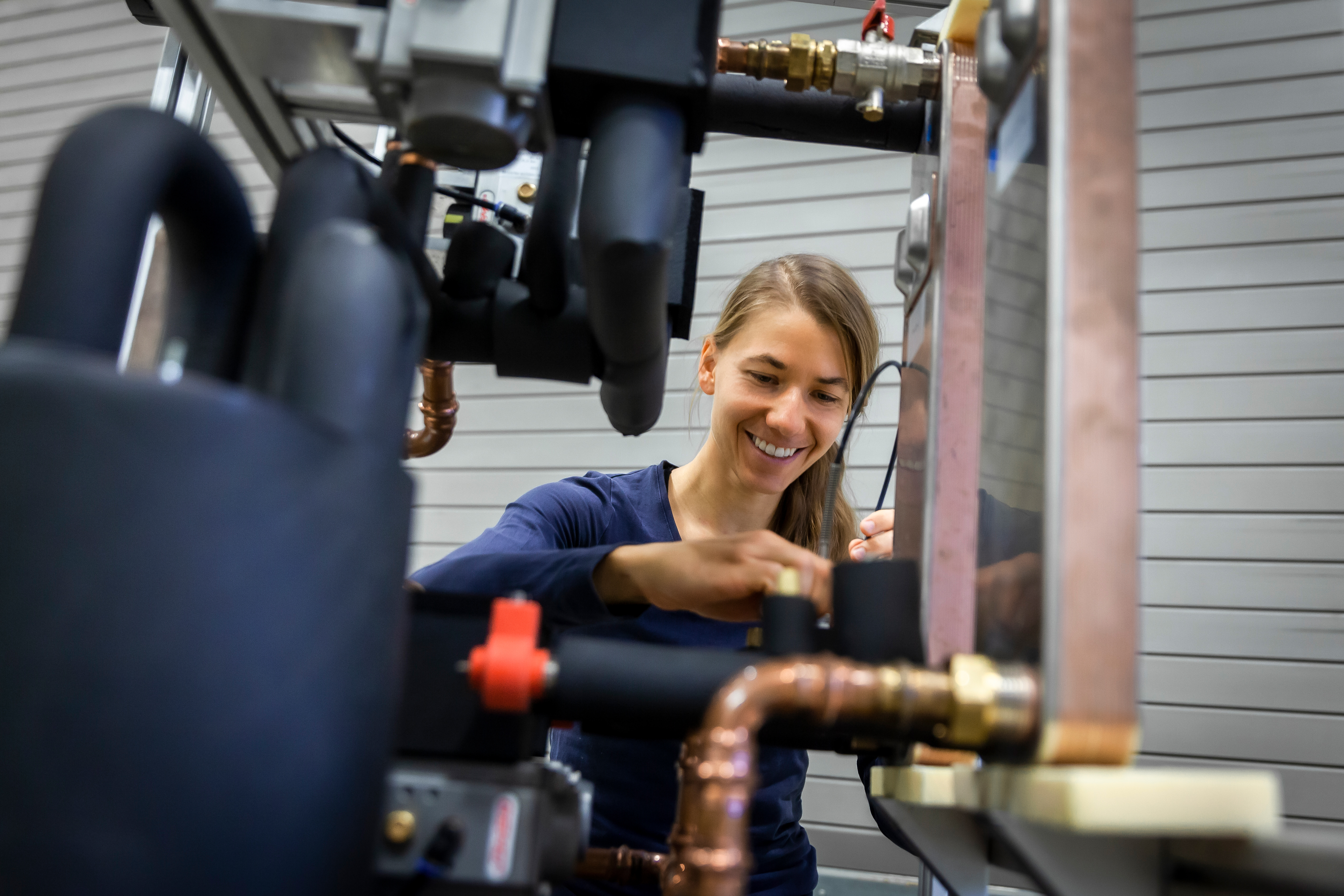Press Release #22
Heat Pumps in Single-Family Houses: Fraunhofer ISE Develops Optimized Propane Refrigeration Circuit
Heat pumps are a key technology in the heat transition, but many of the devices still use environmentally harmful refrigerants. The Fraunhofer Institute for Solar Energy Systems ISE has now developed a functional model of a re-frigeration circuit using propane, a climate-friendly and cost-effective refrigerant alternative. One of the best results was a brine heat pump, achieving a heating capacity of 11.4 kilowatts with only 146 grams of propane. At this low refrigerant charge, it is permitted to install the unit inside buildings without undergoing extensive safety precautions. Per kilowatt of heat output, the unit requires only about one-fifth the amount of propane compared to the systems on the market. The new development is the result of a collaboration between Fraunhofer ISE and an industrial consortium within the "LC150" (Low Charge 150 g) project, which has just ended and was funded by the German Federal Ministry for Economic Affairs and Climate Action. A related, recently started project called "LCR290" (Low Charge R290) will focus on the development of low-charge propane, or R290, heat pumps for multi-family houses.

Many heat pump manufacturers offer propane heat pumps but mostly for outdoor installation only, since the refrigerant is subject to extensive safety regulations for indoor use due to its flammability. If a heat pump in a single-family home with its usual five to ten kilowatts of power exceeds the prescribed maximum of 150 grams of refrigerant charge, then it can be installed only by carrying out increased safety measures.
Fraunhofer ISE's new development could change this: In the recently completed "LC150" project, the researchers and a consortium of heat pump manufacturers developed a low-charge refrigeration circuit that uses a reduced amount of propane. To achieve this, the research team set up, measured, evaluated and optimized more than 20 different combinations of heat exchangers and compressors. Among the most promising results was a module producing a heating capacity of 11.4 kilowatts with a fully hermetic compressor using only 146 grams of propane, thus falling below the prescribed maximum for indoor use. The specific refrigerant charge of the unit is 12.8 grams per kilowatt, which is about one-fifth the propane charge of commercially available systems.
"The project goal was to develop a nearly market-ready heat pump module which uses the climate-friendly refrigerant propane, does not exceed the 150-gram limit for indoor use and yet still provides sufficient heat for single-family homes," says Dr. Lena Schnabel, Head of the Heating and Cooling Department at Fraunhofer ISE. "We have now achieved this goal in cooperation with our industry partners and have given them the tools to develop a market-ready heat pump."
The team used commercially available components for the prototype with a key component being the asymmetrical plate heat exchangers, which require less refrigerant. The research team was able to significantly reduce refrigerant requirements by decreasing the amount of oil in the compressor, among other things. Additional components, such as sensors, were kept to a minimum, and pipes were kept as short as possible to reduce the amount of refrigerant required.
Propane as alternative to F-gas refrigerants
Currently, heat pumps on the market often use fluorinated greenhouse gases (F-gases) as refrigerant. Although the refrigerant remains in the closed thermodynamic cycle, parts of the substances can be released into the atmosphere during the manufacturing, filling and repair processes. The EU Regulation on Fluorinated Greenhouse Gases, or F-gas Regulation, which stipulates a continuous reduction in the climate-damaging potential of refrigerants, is currently under amendment. Refrigerants with a Global Warming Potential (GWP) greater than 2,500 have been banned since 2020, for example.
Propane, also known as R290, is an environmentally friendly alternative with a GWP of three, which is much lower than conventional refrigerants. By comparison, the refrigerant R410A has a GWP of 2,088.
In addition, propane is available worldwide at low cost and has very good thermodynamic properties that enable higher efficiencies, as compared to conventional heat pumps. And unlike some of the low-GWP refrigerants used to date, no critical perfluorinated and polyfluorinated alkyl compounds (PFAS) are released into the atmosphere during the degradation of propane.
Propane Heat Pumps for Multi-family Houses
The next step for the Fraunhofer researchers is the development of propane heat pumps for use in multi-family houses, which started in December 2022 with the launch of the new project "LCR290 - Low Charge Heat Pump Solutions." Together with heating manufacturers and the housing industry, the researchers are to develop solutions for replacing gas and oil heating systems in multi-family houses that are easy to implement and can be applied broadly. The project partners aim to develop heat pump solutions for three fields of application: floor heating systems, central heating systems installed indoors, and heat pumps in the higher performance classes which are installed outdoors. For the floor heating system, the project partners will draw on the results of the "LC150" project to develop suitable storage and source concepts, solutions for the connection to the hydraulic and source system, and adequate control approaches.
The budget of the new joint project is seven million euros. As with the "LC150" project, this project is also funded by the German Federal Ministry for Economic Affairs and Climate Action. The LC290 project will run until June 30, 2025.
Last modified: